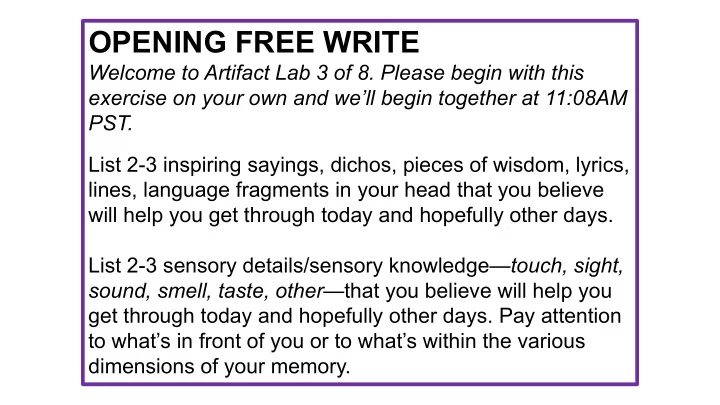

OPENING FREE WRITE Welcome to Artifact Lab 3 of 8. Please begin with this exercise on your own and we’ll begin together at 11:08AM PST. List 2-3 inspiring sayings, dichos, pieces of wisdom, lyrics, lines, language fragments in your head that you believe will help you get through today and hopefully other days. List 2-3 sensory details/sensory knowledge— touch, sight, sound, smell, taste, other —that you believe will help you get through today and hopefully other days. Pay attention to what’s in front of you or to what’s within the various dimensions of your memory.
WELCOME TO ARTIFACT LAB 3 OF 8! WORKSHOP PRINCIPLES Care for self, care for others, care for body, care for land, care toward genuine & practical freedoms & decolonizations. Set intentions upfront—for whom & for what are you showing up? Think & create with a humble, generous, & “radical intellectual openness” (Critical Ethnic Studies Collective), which is to say, CREATE CONTINGENTLY, be open to failure, rather, be open to learning through writing.
LEARNING OUTCOME To compose an artifact that cites, documents, and describes that which will carry us through the day. THE PROCESS FREE WRITE sayings, dichos, fragments, sensory knowledge INTRODUCTION what inspires this space GUIDING TEXTS “Making Feminist Points” (Sara Ahmed) FORM pantoum MODEL TEXT “Descent of the Composer” (Airea D. Matthews) WRITING TIME compose the pantoum/artifact! SHARE share, reflect, lift each other
GUIDING TEXT Ahmed, Sara. “Making Feminist Points.” feministkilljoys.com , Sept. 11, 2013. “I would describe citation as a rather successful reproductive technology, a way of reproducing the world around certain bodies.” “These citational structures can form what we call disciplines.” “The reproduction of a discipline can be the reproduction of these techniques of selection , ways of making certain bodies and thematics core to the discipline, and others not even part.”
FORM The (very brief) pantoum: cycling, repetition, possibility—i.e. a poem of the “best” hooks of your life! 1 2 3 4 2 5 4 6 5 7 6 8 7 3 8 1
MODEL TEXT Matthews, Airea D. “Descent of the Composer.” Poets.org, October 24, 2016.
WRITING TIME Compose a poem of (deep) citations, sayings, the language that’ll carry you through today. Fill in the structure of the pantoum with language from the opening free write, Ahmed’s sage critique, and/or Matthew’s model pantoum. Feel free, too, to conjure up more sensory details, more sayings—listen to what’s going on in your head/heart/body. OR Simply be open, be free, and assemble the pantoum that is calling you right now. CITE YOUR SOURCES AS A PRAXIS OF INTELLECTUAL KINSHIP AND SOLIDARITY.
JASON MAGABO PEREZ
Recommend
More recommend